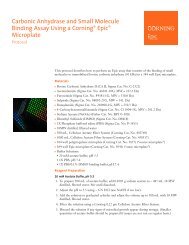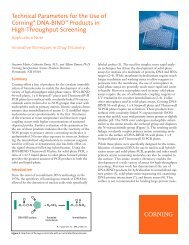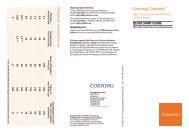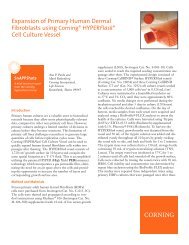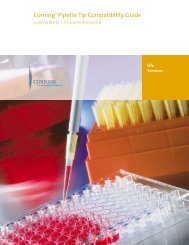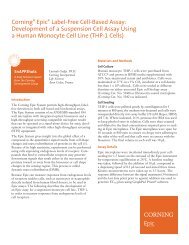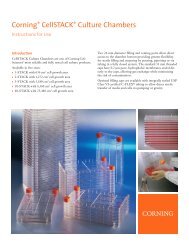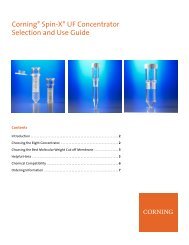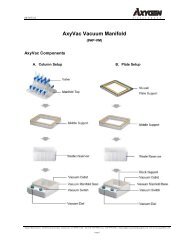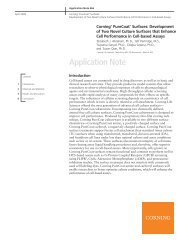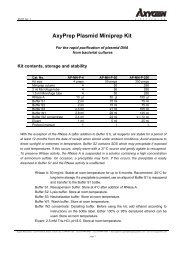Cryogenic Preservation And Storage Of Animal Cells - Corning ...
Cryogenic Preservation And Storage Of Animal Cells - Corning ...
Cryogenic Preservation And Storage Of Animal Cells - Corning ...
You also want an ePaper? Increase the reach of your titles
YUMPU automatically turns print PDFs into web optimized ePapers that Google loves.
<strong>Cryogenic</strong> <strong>Preservation</strong> and <strong>Storage</strong> of <strong>Animal</strong> <strong>Cells</strong><br />
John A. Ryan, Ph.D.<br />
<strong>Corning</strong> Incorporated<br />
Life Sciences<br />
45 Nagog Park<br />
Acton, MA 01720<br />
Introduction<br />
<strong>Cryogenic</strong> preservation (storage below -100°C) of cell cultures is widely used<br />
to maintain backups or reserves of cells without the associated effort and<br />
expense of feeding and caring for them. The success of the freezing process<br />
depends on four critical areas:<br />
1. Proper handling and gentle harvesting of the cultures<br />
2. Correct use of the cryoprotective agent<br />
3. A controlled rate of freezing<br />
4. <strong>Storage</strong> under proper cryogenic conditions<br />
The last three points are discussed in more detail below.<br />
A wide variety of chemicals provide adequate cryoprotection. However,<br />
dimethylsulfoxide (DMSO) and glycerol are the most convenient and widely<br />
used. DMSO is most often used at a final concentration of 5 to15% (v/v).<br />
Some cell lines are adversely affected by prolonged contact with DMSO. This<br />
can be reduced or eliminated by adding the DMSO to the cell suspension at 4°C<br />
and removing it immediately upon thawing. If this does not help, lower the<br />
concentration or try glycerol. Glycerol is generally used at a final concentration<br />
of between 5 and 20% (v/v). Although less toxic to cells than DMSO, glycerol<br />
can cause osmotic problems, especially after thawing. Always add it at room<br />
temperature or above, and remove slowly by dilution. High serum<br />
concentrations may also help cells survive freezing. Replacing standard<br />
1
Be prepared for<br />
emergencies. Learning<br />
that your liquid nitrogen<br />
freezer has failed without<br />
warning (destroying the<br />
cultures contained within)<br />
is a terrible but all too<br />
common event. Frequently<br />
check nitrogen levels in<br />
freezers; a schedule<br />
should be established and<br />
strictly adhered to. Audible<br />
alarm systems for detecting<br />
low liquid nitrogen<br />
levels are available to<br />
provide additional<br />
safeguards. However, they<br />
provide a false sense of<br />
security if not monitored<br />
24 hours a day. Valuable<br />
or irreplaceable cultures<br />
should be stored in at least<br />
two separate facilities.<br />
ATCC provides a safe<br />
deposit service for this<br />
purpose; they can be<br />
contacted at (703) 365-<br />
2700 for additional<br />
information on this service.<br />
medium-cryoprotectant mixtures with 95% serum and 5% DMSO may be<br />
superior for some overly sensitive cell lines, especially hybridomas.<br />
The cooling rate used to freeze cultures must be just slow enough to allow the<br />
cells time to dehydrate, but fast enough to prevent excessive dehydration<br />
damage. A cooling rate of -1°C to -3°C per minute is satisfactory for most<br />
animal cell cultures. Larger cells or cells having less permeable membranes<br />
may require a slower freezing rate since their dehydration will take longer.<br />
The best way to control cooling rates is by using electronic programmable<br />
freezing units. Although expensive, they allow precise control of the freezing<br />
process, give very uniform and reproducible results and can freeze large<br />
numbers of vials. Most units are available with chart recorders for a permanent<br />
record of the cooling process. There are a variety of mechanical freezing units<br />
that provide adequate control of the cooling rate and are relatively inexpensive.<br />
Some systems use racks designed to hold vials at predetermined depths in the<br />
neck of a liquid nitrogen freezer. The cooling rate is dependent on the total<br />
number of vials and the depth at which the rack is placed. Another approach<br />
uses an alcohol-filled container designed to slowly freeze vials placed in the<br />
system. The filled container is placed in an ultracold mechanical freezer where<br />
the alcohol acts as a bath to achieve more uniform heat transfer and cooling.<br />
After freezing overnight, the vials are removed from the canister and<br />
transferred to their final storage locations.<br />
Only freezers capable of continually maintaining temperature below -130°C<br />
should be considered for long-term cryogenic storage. Although most liquid<br />
nitrogen cooled freezers and some specially designed mechanical freezers meet<br />
this requirement, most cell culture laboratories prefer liquid nitrogen freezers.<br />
The final choice is often based on the availability of a reliable supply of liquid<br />
nitrogen, the storage capacity required and the size of the budget. Liquid<br />
nitrogen freezers permit storage either in the vapor phase above the liquid at<br />
temperature between -140°C and -180°C, or submerged in the liquid at a<br />
temperature below -196°C. Using vapor phase storage greatly reduces the<br />
possibility of leaky vials or ampules exploding during removal.<br />
The following procedure can be easily adapted to a wide variety of cell lines.<br />
For additional information and references refer to the General Guide for<br />
<strong>Cryogenic</strong>ally Storing <strong>Animal</strong> Cell Cultures on the <strong>Corning</strong> Life Sciences<br />
Technical Information web site at www.corning.com/lifesciences.<br />
Supplies<br />
Nonsterile<br />
1. Pipetting aids<br />
2. Disposal tray or bucket for discarding used pipettes<br />
3. Bottle of 70% alcohol for wiping down work area<br />
4. Paper towels<br />
5. Marking pen<br />
6. Controlled rate freezer. There are a variety of mechanical freezing units that<br />
provide adequate control of the cooling rate and are relatively inexpensive:<br />
Stratagene StrataCooler Catalog # 400005 or 400006.<br />
7. Inverted phase contrast microscope<br />
8. Ice bucket<br />
9. Liquid waste container<br />
10. Hemacytometer or electronic cell counter<br />
2
<strong>Corning</strong> offers a variety of<br />
cryogenic vial sizes and<br />
cap styles. Visit the on-line<br />
catalog (www.corning.com/<br />
lifesciences) to find out<br />
more about these products.<br />
11. Laminar flow hood<br />
Sterile<br />
1. Cell culture medium appropriate for the cell line being frozen<br />
2. Healthy, near confluent cell culture in T-75 flask.<br />
3. 1, 5, 10 and 25mL pipettes - <strong>Corning</strong> ® Catalog # 4485, 4487, 4488 and<br />
4489<br />
4. 15mL screw cap centrifuge tubes - <strong>Corning</strong> Catalog # 430055 or 430788<br />
5. Phosphate Buffered Saline: Calcium- and Magnesium-free (CMF-PBS).<br />
Unlike Hanks’ and Earle’s buffered saline solutions, CMF-PBS is designed<br />
to maintain a physiological pH in an open system. The calcium and<br />
magnesium is removed because these cations play a role in cell-to-cell<br />
attachment.<br />
6. Trypsin solution or other dissociating agent in CMF-PBS. Trypsin<br />
concentration should be optimized so as to remove the cells as quickly as<br />
possible but with a minimum of stress or damage.<br />
7. 2mL <strong>Cryogenic</strong> vials - <strong>Corning</strong> Catalog # 430661, 2027 or 430489<br />
8. Cryoprotective medium - complete culture medium containing 10%<br />
dimethylsulfoxide (DMSO). Always use reagent or other high purity grades<br />
that have been tested for cell culture suitability (American Type Culture<br />
Collection,1-800-638-6597, ATCC Catalog #4-X). Sterilize DMSO by<br />
filtration through a 0.2µm nylon membrane (<strong>Corning</strong> Catalog # 431224) in<br />
a polypropylene or stainless steel housing and store in small quantities<br />
(5mL).<br />
9. 0.04% Trypan blue solution for viability staining<br />
Procedure<br />
Examination:<br />
Prior to freezing, the cells should be maintained in an actively growing state to<br />
insure maximum health and a good recovery. Ideally, the culture medium<br />
should be changed the previous day. Using an inverted microscope, quickly<br />
check the general appearance of the culture. Look for signs of microbial<br />
contamination. It is also important to examine the culture with the unaided eye<br />
to look for small fungal colonies that may be floating at the medium-air<br />
interface and thus not visible through the microscope. It is best if the cultures<br />
are maintained antibiotic-free for at least one week prior to freezing to help<br />
uncover any cryptic (hidden) culture contaminants.<br />
Cell Harvesting and Freezing:<br />
Treat the cells gently during harvesting since it is very difficult for cells<br />
damaged during harvesting to survive the additional damage that occurs during<br />
the freezing and thawing processes. You should be able to obtain up to 1.5x10 7<br />
cells from a near confluent T-75 flask (depending on cell type and degree of<br />
confluency). This should be enough cells to set up at least several vials at 2x10 6<br />
cells/vial.<br />
1. Using a sterile pipette, remove and discard the old culture medium.<br />
2. For a T-75 flask, rinse the cell monolayer with 5mL of calcium- and<br />
magnesium-free phosphate buffered saline (CMF-PBS) to remove all traces<br />
of fetal bovine serum.<br />
3. Add 4 to 5mL of the trypsin solution (in CMF-PBS) to the flask and allow<br />
cells to incubate for at least one minute. (Prewarming of the enzyme<br />
3
CAUTION: Take special<br />
care to avoid contact with<br />
solutions containing<br />
DMSO. It is a very<br />
powerful polar solvent<br />
capable of rapidly<br />
penetrating intact skin and<br />
carrying in with it harmful<br />
contaminants such as<br />
carcinogens or toxins.<br />
CAUTION: <strong>Corning</strong><br />
strongly recommends that<br />
cryogenic vials always be<br />
stored in the vapor phase<br />
above the liquid nitrogen<br />
to reduce the possibility of<br />
the vials filling with liquid<br />
nitrogen during extended<br />
storage. Vials filled with<br />
liquid nitrogen may<br />
explode violently upon<br />
removal from the freezer.<br />
CAUTION: Always use<br />
appropriate safety equipment<br />
when removing vials<br />
and ampules from liquid or<br />
vapor phase nitrogen<br />
freezers. A full-face<br />
shield, heavy gloves and<br />
lab coat are strongly<br />
recommended for protection<br />
against exploding vials<br />
or ampules.<br />
solution will decrease the exposure period.) Withdraw about 3mL of the<br />
trypsin solution and allow the cells to round up and loosen.<br />
4. Check the progress of the enzyme treatment every few minutes on an<br />
inverted phase contrast microscope. Once all of the cells have rounded up,<br />
gently tap the flask to detach them from the plastic surface. Then add 5mL<br />
of growth medium to the cell suspension and, using the same pipette,<br />
vigorously wash any remaining cells from the bottom of the culture vessel.<br />
5. Collect the suspended cells in a 15mL centrifuge tube and place on ice.<br />
Take a sample for counting and then spin at 100xg for 5 minutes to obtain a<br />
cell pellet. While the cells are spinning, do a viable cell count (with the<br />
trypan blue solution) and calculate the number of cells/mL and the total cell<br />
number.<br />
6. Remove the supernatant from the centrifuged cells and resuspend the cell<br />
pellet in enough of the cryoprotective medium containing 10% DMSO<br />
(DMSO is most often used at a final concentration of 5 to 15%.) to give a<br />
final cell concentration of 1 to 2x10 6 cells/mL. Although not directly toxic,<br />
DMSO is a very powerful solvent and is able to rapidly penetrate intact<br />
skin (leaving a fishy or garlicky taste in your mouth). As a result, there is a<br />
POTENTIAL HAZARD associated with using this compound. It is very<br />
important to avoid contact with DMSO and dispose of any wastes<br />
containing DMSO properly.<br />
7. Label the appropriate number of cryogenic vials with the cell line, and the<br />
date. Then add 1.5 to 1.8mL of the DMSO containing cell suspension to<br />
each of the vials and seal.<br />
8. Place the vials in the controlled rate freezer overnight. After 24 hours, the<br />
cells should be transferred to a liquid nitrogen freezer for permanent<br />
storage.<br />
9. Record the appropriate information about the cells in your cell repository<br />
records. Fully detail in these records the culture's storage conditions,<br />
including all of the following information: culture identity, passage or<br />
population doubling level, date frozen, freezing medium and method used,<br />
number of cells per vial, total number of vials initially frozen and the<br />
number remaining, their locations, their expected viability and results of all<br />
quality control tests performed (sterility, mycoplasma, species, karyotype,<br />
etc.). Additional culture information, especially its origin, history, growth<br />
parameters, special characteristics and applications, is also helpful and<br />
should be included whenever possible.<br />
Cell Thawing and Recovery:<br />
1. Using appropriate safety equipment, remove the vial from its storage<br />
location and carefully check both the label and storage record to ensure that<br />
it is the correct culture. Place the vessel in warm water, agitating gently<br />
until completely thawed. Rapid thawing (60 to 90 seconds at 37°C)<br />
provides the best recovery for most cell cultures; it reduces or prevents the<br />
formation of damaging ice crystals within cells during rehydration.<br />
2. Since some cryoprotective agents may damage cells upon prolonged<br />
exposure, remove the agents as quickly and gently as possible. Several<br />
approaches are used depending on both the cryoprotective agents and<br />
characteristics of the cells:<br />
a) Most cells recover normally if they have the cryoprotective agent<br />
removed by a medium change within 6 to 8 hours of thawing. Transfer<br />
4
the contents of the ampule or vial to a T-75 flask or other suitable<br />
vessel containing 15 to 20mL of culture medium and incubate<br />
normally. As soon as a majority of the cells have attached (usually 3 to<br />
4 hours), remove the medium containing the now diluted cryoprotective<br />
agent and replace with fresh medium.<br />
b) For cells that are sensitive to cryoprotective agents, removing the old<br />
medium is easily accomplished by gentle centrifugation. Transfer the<br />
contents of the vial or ampule to a 15mL centrifuge tube containing<br />
10mL of fresh medium and spin for 5 minutes at 100xg. Discard the<br />
supernatant containing the cryoprotective agent and resuspend the cell<br />
pellet in fresh medium. Then transfer the cell suspension to a suitable<br />
culture vessel and incubate normally.<br />
For additional product or technical information, please visit the <strong>Corning</strong> Life<br />
Sciences web site at www.corning.com/lifesciences or call at 1-800-492-1110.<br />
International customers can call at 978-635-2200.<br />
Acknowledgements<br />
This protocol has evolved from protocols developed for cell culture training<br />
courses at the former W. Alton Jones Cell Science Center in Lake Placid, New<br />
York; Manhattan College, New York City; and the University of Connecticut,<br />
Storrs, Connecticut. I would like to thank all of my colleagues and students<br />
who, over the years, have contributed ideas and suggestions to its development.<br />
References<br />
1. Freshney, R. I., 1994. Culture of <strong>Animal</strong> <strong>Cells</strong>: A Manual of Basic<br />
Technique, pages 254-263. (3rd edition); Wiley-Liss, New York.<br />
2. Hay, R. J., 1978. <strong>Preservation</strong> of Cell Culture Stocks in Liquid<br />
Nitrogen, pages 787-790. TCA Manual 4.<br />
3. Schroy, C. B., and P. Todd, 1976. A Simple Method for Freezing and<br />
Thawing Cultured <strong>Cells</strong>, pages 309-310. TCA Manual 2, Procedure<br />
Number 76035.<br />
4. Shannon, J. E. and M. L. Macy, 1973. Freezing, <strong>Storage</strong>, and Recovery of<br />
Cell Stocks, pages 712-718. In Tissue Culture: Methods and Applications.<br />
P. F. Kruse and M. K. Patterson Jr. Eds. (Academic Press, New York).<br />
5. Waymouth, C. and D. S. Varnum, 1976. Simple Freezing Procedure for<br />
<strong>Storage</strong> in Serum-free Media of Cultured and Tumor <strong>Cells</strong> of Mouse,<br />
pages 311-313. TCA Manual 2, Procedure Number 76165.<br />
<strong>Corning</strong> Incorporated Worldwide India Taiwan United Kingdom<br />
Life Sciences Support <strong>Of</strong>fices t 91 11 341 3440 t 886 2-2716-0338 t 0800 376 8660<br />
f 91 11 341 1520 f 886 2-2716-0339 f 0800 279 1117<br />
45 Nagog Park ASIA<br />
Acton, MA 01720 Japan EUROPE LATIN AMERICA<br />
t 800.492.1110 Australia t 81 (0) 3-3586 1996<br />
t 978.635.2200 t 61 2-9416-0492 f 81 (0) 3-3586 1291 France Brasil<br />
f 978.635.2476 f 61 2-9416-0493 t 0800 916 882 t (55-11) 3089-7420<br />
Korea f 31 20 659 7673 f (55-11) 3167-0700<br />
www.corning.com/ China t 82 2-796-9500<br />
lifesciences t 86 21-3222-4666 f 82 2-796-9300 Germany Mexico<br />
f 86 21-6288-1575 t 0800 101 1153 t (52-81) 8313-8586<br />
Singapore f 0800 101 2427 f (52-81) 8313-8589<br />
Hong Kong t 65 6733-6511<br />
t 852-2807-2723 f 65 6735-2913 The Netherlands<br />
f 852-2807-215 t 31 (0) 20 655 79 28<br />
f 31 (0) 20 659 76 73<br />
<strong>Corning</strong> is a registered trademark of <strong>Corning</strong> Incorporated, <strong>Corning</strong> New York<br />
5



